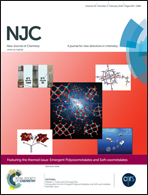On the formation of gold nanoparticles from [AuIIICl4]− and a non-classical reduced polyoxomolybdate as an electron source: a quantum mechanical modelling and experimental study†
Abstract
Polyoxometalate (POM)-mediated reduction and nucleation mechanisms in nanoparticle (NP) syntheses are still largely unknown. We carried out comprehensive theoretical analysis using density functional theory (DFT) to gain insight into the molecular and electronic changes that occur during the reduction of HAuIIICl4 with the Kabanos-type polyoxomolybdate, [Na{(MoV2O4)3(μ2-O)3(μ2-SO3)3(μ6-SO3)}2]15−. In the system presented herein the electrons are supplied by the POM, making the computational thermodynamic analysis more feasible. Our results reveal that this particular POM is a multi-electron source and the proton-coupled electron transfer (PCET) greatly promotes the reduction process. Based on the energy and molecular orbital studies of the intermediate species the reduction of AuIII to AuI is shown to be thermodynamically favourable, and a low HOMO–LUMO gap of the POM–Au superstructure is advantageous for electron transfer. By modelling the reduction of three couples of AuIII → AuI by the same POM unit, it is proposed that the reduced polyoxomolybdate is finally fully oxidised. The subjacent idea of using the Kabanos POM was confirmed by comprehensive experimental characterisation of POM-stabilised gold nanoparticles (AuNPs@POM). Present theoretical analysis suggests that protons have a significant influence on the final AuI to Au0 reduction step that ultimately leads to colloidal AuNPs@POM.
![Graphical abstract: On the formation of gold nanoparticles from [AuIIICl4]− and a non-classical reduced polyoxomolybdate as an electron source: a quantum mechanical modelling and experimental study](/en/Image/Get?imageInfo.ImageType=GA&imageInfo.ImageIdentifier.ManuscriptID=C5NJ02773J&imageInfo.ImageIdentifier.Year=2016)
- This article is part of the themed collection: Emergent Polyoxometalates and Soft-oxometalates

 Please wait while we load your content...
Please wait while we load your content...